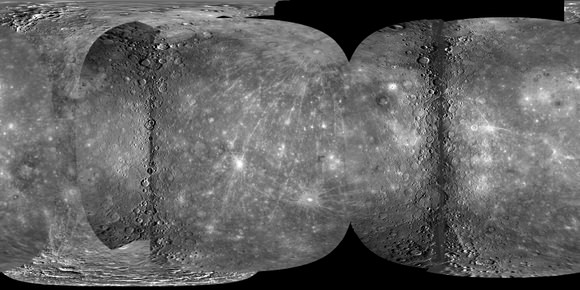The first-ever global mosaic map of Mercury was released today, which will be a critical tool for the MESSENGER mission’s observations of the planet when it enters orbit in 2011. The map was created from images taken during MESSENGER’s three flybys of Mercury – the most recent of which took place in September 2009 — and those of Mariner 10 in the 1970s. “The production of this global mosaic represents a major milestone for everyone on the MESSENGER imaging team,” said Sean Solomon, MESSENGER Principal Investiagor. “Beyond its extremely important use as a planning tool, this global map signifies that MESSENGER is no longer a flyby mission but instead will soon become an in-depth, non-stop global observatory of the Solar System’s innermost planet.”
The map was created by the MESSENGER mission team and cartographic experts from the U. S. Geological Survey. It will help scientists pinpoint craters, faults, and other features for observation.
While creating a mosaic map may seem straightforward – just stitch together multiple images taken by the spacecraft — it was actually quite a challenge to create cartographically accurate maps from images with varying resolution (from about 100 to 900 meters per pixel) and lighting conditions (from noontime high Sun to dawn and dusk) taken from a spacecraft traveling at speeds greater than 2 kilometers per second (2,237 miles per hour).
Small uncertainties in camera pointing and changes in image scale can introduce small errors between frames.
“With lots of images, small errors add up and lead to large mismatches between features in the final mosaic,” said MESSENGER team member Mark Robinson. “By picking control points—the same features in two or more images—the camera pointing can be adjusted until the image boundaries match.”
This operation is known as a bundle-block adjustment and requires highly specialized software. Cartographic experts at the USGS Astrogeology Science Center in Flagstaff, Ariz., picked the control points to solve the bundle-block adjustment to construct the final mosaic using the Integrated Software for Imagers and Spectrometers (ISIS). For the MESSENGER mosaic, 5,301 control points were selected, and each control point on average was found in more than three images (18,834 measurements) from a total of 917 images.
“This mosaic represents the best geodetic map of Mercury’s surface. We want to provide the most accurate map for planning imaging sequences once MESSENGER achieves orbit around Mercury”, said Kris Becker of the USGS. “As the systematic mapping of Mercury’s surface progresses, we will continually add new images to the control point network, thus refining the map”, he says. “It has already provided us with a start in the process of naming newly identified features on the surface.”
In the final bundle-block adjustment the average error was about two-tenths of a pixel or only about 100 meters—which is an excellent match from image-to-image, the team said. Absolute positional errors in the new mosaic are about two kilometers, according to the MESSENGER team. Once the spacecraft enters orbit around Mercury, the team will be able to make even more refinements and the entire planet will be imaged at even higher resolution. The global mosaic is available for download on the USGS Map-a-Planet web site. It is also available at the MESSENGER site.
A presentation on the new global mosaic was given today at the Fall Meeting of the American Geophysical Union in San Francisco.
Source: MESSENGER


Can ‘Google Mercury’ be far off?
The thing that stands out the most to me is the dark band that goes all around Mercury in the north-south direction. Anyone know what it is? (Imaging artifact due to lighting conditions?)
@Yoo
If you zoom in it looks to be where the images were stiched together, although oddly enough it seems to be the most detailed area of the mapping.
Yoo, SuperKevin: you’re right, this is where images were stitched, just next to where the terminator happened to be for each of the passes.
Jon you stole my Thunder! Google Solar System must not be far down the road either!
Now when will we get Google Mercury?
Darn those unoriginal comments of mine…